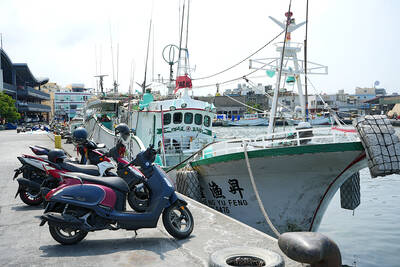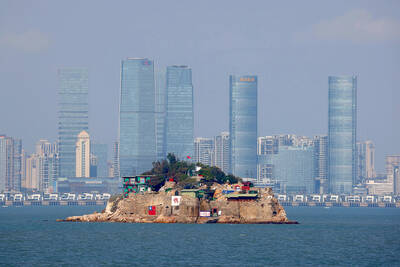The administration of President Ma Ying-jeou (馬英九) has been “obviously deficient” in aligning Taiwan’s defense with diplomacy, charges a paper published on Wednesday by the Brookings Institution in Washington.
“Taiwan must rethink its practices for interagency collaboration and make some tangible action plans,” said Huang Kwei-bo (黃奎博), an associate professor of diplomacy at National Chengchi University, in the paper.
He said that in May 2011, Ma detailed three lines of defense to enhance Taiwan’s international status and security in the face of a rising China.
The first two — institutionalization of cross-strait rapprochement and the utilization of Taiwan’s geographic location, infrastructure and democracy to interact with the rest of the world — have been “implemented with some success.”
However, according to Huang, the third line of defense — “aligning Taiwan’s defense with diplomacy” — is supported by few detailed and deliberate action plans.
“While the outlines of this third line of defense are visible, it is evident that Taiwan has not brought the different strands of this idea together to substantially connect,” he said.
Huang said that maintaining an appropriate self-defense capability while preventing war in a diplomatic way “is a common-sense objective for Taiwan.”
One major problem, according to Huang, is that the Ministry of National Defense (MND) and the Ministry of Foreign Affairs (MOFA) need better collaboration.
“What Taiwan really needs at this time is stronger initiative and persistent fostering of cross-agency interactions that can facilitate the goal of aligning defense with diplomacy,” Huang said.
“Better and consistent coordination within both MOFA and MND is required,” he said.
Except at the top leadership level, the exchange and sharing of information between the ministries “has not been institutionalized satisfactorily.”
“As neither MND nor MOFA is sufficiently organized and trained to plan, coordinate and integrate the resources and mechanisms available for the establishment of the third line of defense, at the present time Taiwan is not able to achieve this goal,” he said.
US arms sales and political support remain “crucial” for Taiwan’s national security, but are not enough by themselves.
“Taiwan must speed up its interagency collaboration now, beginning with MND and MOFA,” Huang said.
However, it will require political investment from the president.
Ma must know that his national security triad will not function as expected if any of the defense lines is ignored or mismanaged, he said.
“Nevertheless, it remains to be seen whether the in-depth shaping and adjustment of the third line of defense will take place in the near future, especially as the administration is confronting a series of serious and intricate domestic and external challenges,” he said.

Left-Handed Girl (左撇子女孩), a film by Taiwanese director Tsou Shih-ching (鄒時擎) and cowritten by Oscar-winning director Sean Baker, won the Gan Foundation Award for Distribution at the Cannes Critics’ Week on Wednesday. The award, which includes a 20,000 euro (US$22,656) prize, is intended to support the French release of a first or second feature film by a new director. According to Critics’ Week, the prize would go to the film’s French distributor, Le Pacte. "A melodrama full of twists and turns, Left-Handed Girl retraces the daily life of a single mother and her two daughters in Taipei, combining the irresistible charm of

A Philippine official has denied allegations of mistreatment of crew members during Philippine authorities’ boarding of a Taiwanese fishing vessel on Monday. Philippine Bureau of Fisheries and Aquatic Resources (BFAR) spokesman Nazario Briguera on Friday said that BFAR law enforcement officers “observed the proper boarding protocols” when they boarded the Taiwanese vessel Sheng Yu Feng (昇漁豐號) and towed it to Basco Port in the Philippines. Briguera’s comments came a day after the Taiwanese captain of the Sheng Yu Feng, Chen Tsung-tun (陳宗頓), held a news conference in Pingtung County and accused the Philippine authorities of mistreatment during the boarding of

The Chinese Communist Party (CCP) is pushing for residents of Kinmen and Lienchiang counties to acquire Chinese ID cards in a bid to “blur national identities,” a source said. The efforts are part of China’s promotion of a “Kinmen-Xiamen twin-city living sphere, including a cross-strait integration pilot zone in China’s Fujian Province,” the source said. “The CCP is already treating residents of these outlying islands as Chinese citizens. It has also intensified its ‘united front’ efforts and infiltration of those islands,” the source said. “There is increasing evidence of espionage in Kinmen, particularly of Taiwanese military personnel being recruited by the

88.2 PERCENT INCREASE: The variants driving the current outbreak are not causing more severe symptoms, but are ‘more contagious’ than previous variants, an expert said Number of COVID-19 cases in the nation is surging, with the Centers for Disease Control (CDC) describing the ongoing wave of infections as “rapid and intense,” and projecting that the outbreak would continue through the end of July. A total of 19,097 outpatient and emergency visits related to COVID-19 were reported from May 11 to Saturday last week, an 88.2 percent increase from the previous week’s 10,149 visits, CDC data showed. The nearly 90 percent surge in case numbers also marks the sixth consecutive weekly increase, although the total remains below the 23,778 recorded during the same period last year,